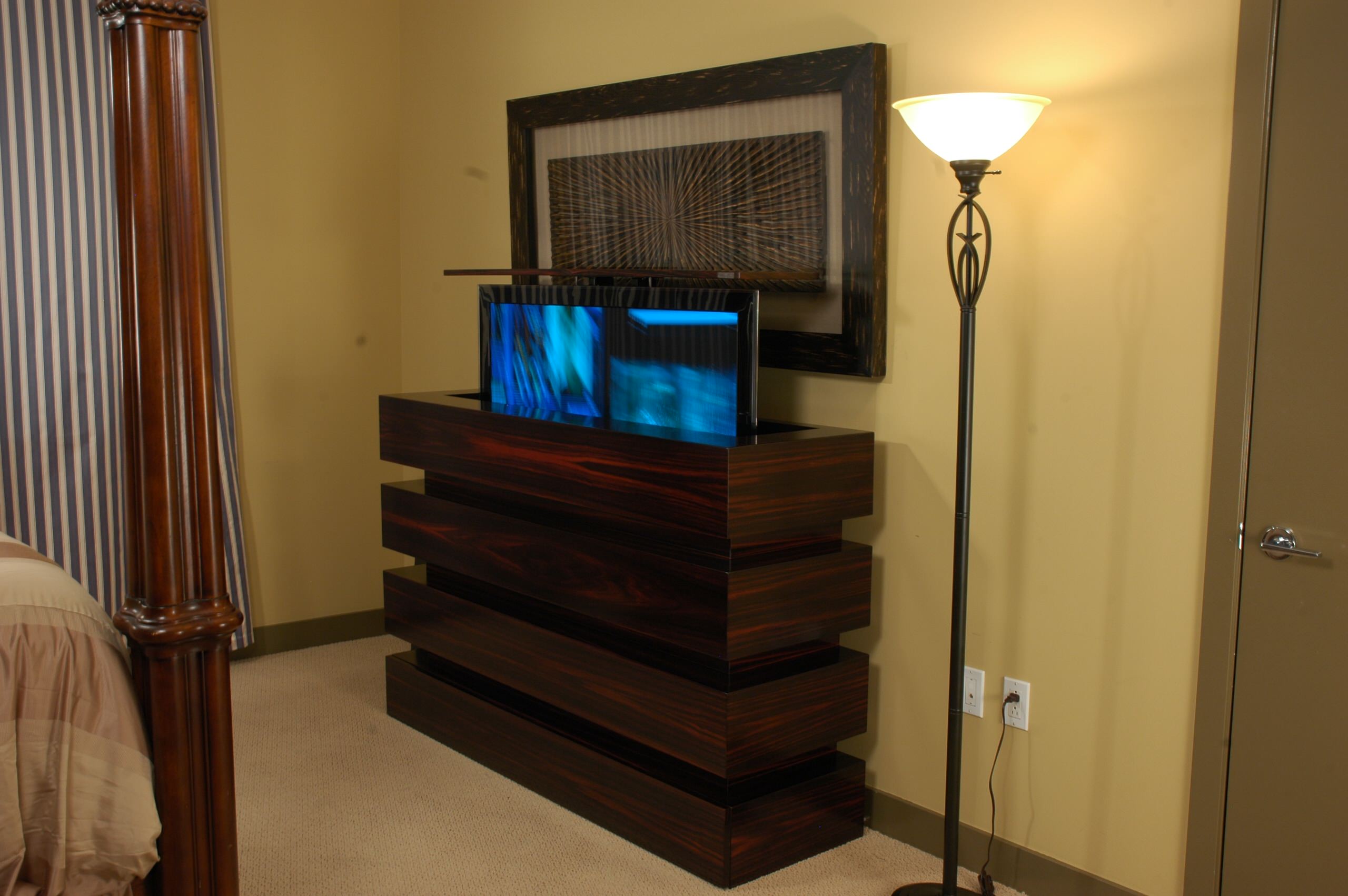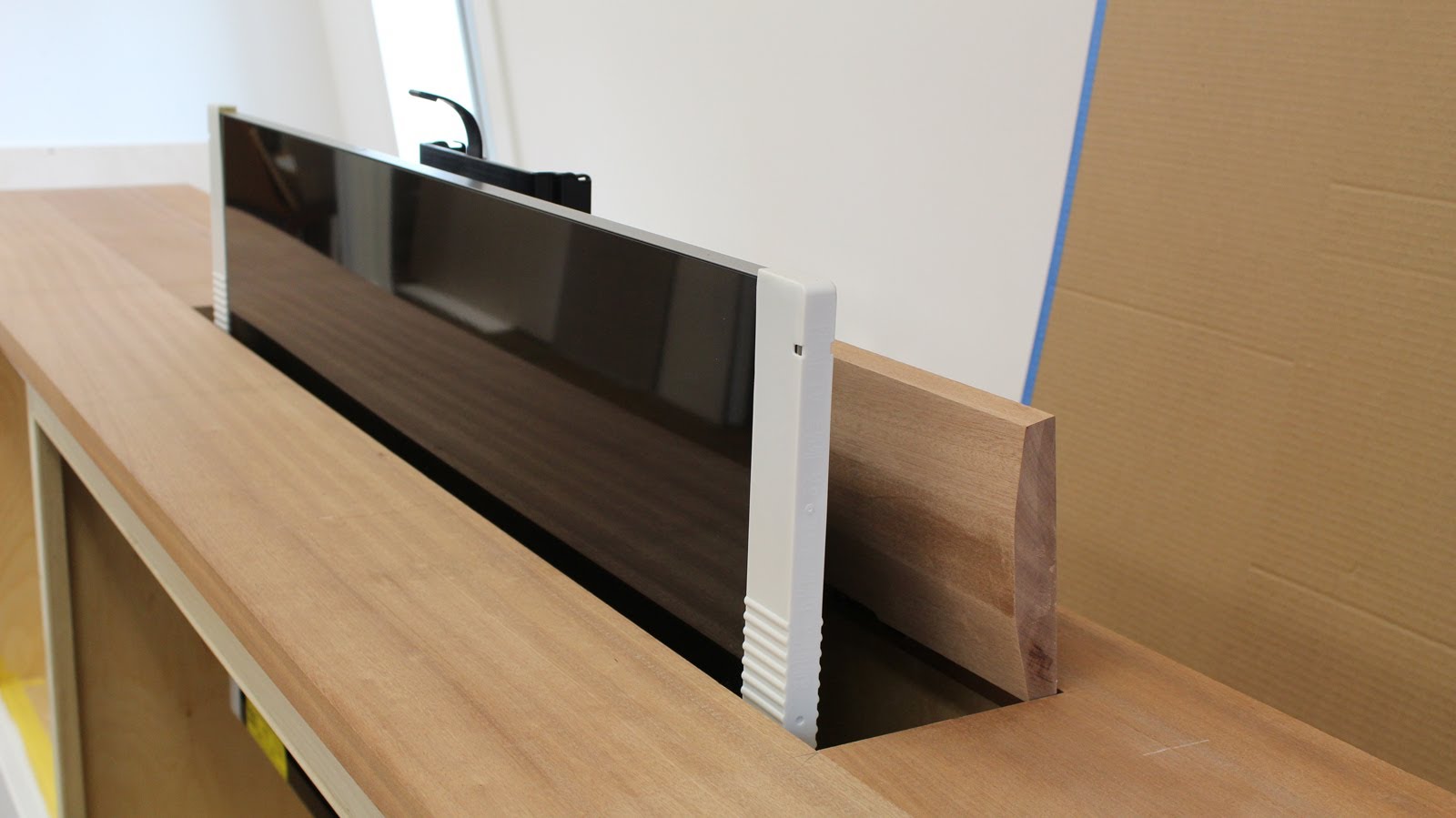Building a DIY Motorized TV Cabinet

A motorized TV cabinet offers a sleek and modern way to enhance your home entertainment setup. With the ability to raise and lower your TV with the push of a button, this project combines functionality with aesthetics.
Essential Tools and Materials
This section details the essential tools and materials needed to build a motorized TV cabinet.
- Power drill: Used for drilling pilot holes and attaching components.
- Screwdriver: For assembling and securing various parts.
- Measuring tape: Crucial for accurate measurements and cutting materials.
- Level: Ensures the cabinet is level and stable.
- Saw: For cutting wood to size, a circular saw or jigsaw is recommended.
- Sandpaper: To smooth out rough edges and prepare surfaces for finishing.
- Wood glue: For bonding wood pieces together.
- Wood screws: For attaching components and securing the structure.
- Plywood: The primary material for constructing the cabinet.
- Motorized lift system: This is the heart of the project, enabling the TV to raise and lower.
- Hardware: Includes hinges, drawer slides, and other necessary components.
- Paint or stain: To give the cabinet a desired finish.
Safety Precautions
This section highlights important safety precautions to be considered during the construction process.
- Wear safety glasses: To protect your eyes from flying debris.
- Use a dust mask: To avoid inhaling sawdust, especially when sanding.
- Work in a well-ventilated area: This minimizes the risk of inhaling fumes from paint or stain.
- Use proper lifting techniques: To avoid injury when handling heavy materials.
- Be mindful of electrical wiring: Exercise caution when working with the motorized lift system and electrical connections.
- Follow manufacturer instructions: Carefully read and follow the instructions provided with the motorized lift system.
Assembling the Basic Structure
This section Artikels the steps involved in assembling the basic structure of the cabinet.
- Cut the plywood: Use the saw to cut the plywood panels to the desired dimensions for the cabinet’s sides, top, bottom, and shelves.
- Assemble the sides: Attach the side panels to the bottom panel using wood glue and screws. Ensure the sides are square and flush.
- Attach the shelves: Install the shelves inside the cabinet, ensuring they are level and secure.
- Attach the top panel: Secure the top panel to the sides and shelves, creating a complete box structure.
- Reinforce the structure: Add additional support, such as bracing or corner blocks, for extra strength and stability.
Integrating the Motorized Mechanism: Diy Motorized Tv Cabinet

The heart of your DIY motorized TV cabinet lies in the motorized mechanism. This section will guide you through selecting the right motor, connecting it to the cabinet, and ensuring its smooth operation.
Motor Selection
The choice of motor depends on the size and weight of your TV cabinet, as well as the desired movement speed and noise level. Here are some common motor types suitable for TV cabinet applications:
- Linear Actuators: These motors provide straight-line movement, ideal for sliding cabinets or extending shelves. They are typically powerful and can handle heavy loads.
- DC Motors: These motors offer rotational motion, suitable for rotating or tilting cabinets. They are generally smaller and quieter than linear actuators.
- Stepper Motors: These motors provide precise and controlled movement, often used for complex cabinet designs with multiple movements. They offer high accuracy and repeatability.
Connecting the Motor to the Cabinet Structure
Connecting the motor to the cabinet structure requires careful planning and execution.
- Mounting Brackets: Use sturdy mounting brackets to secure the motor to the cabinet frame. Ensure the brackets are compatible with the motor type and provide adequate support.
- Connecting Rods: For linear actuators, use connecting rods to transmit the motor’s movement to the cabinet. Choose rods made of durable materials and ensure they are securely fastened.
- Gears and Pulleys: For DC motors, use gears or pulleys to convert rotational motion into linear movement. Select gears and pulleys with appropriate ratios to achieve the desired movement speed and force.
Wiring the Motor and Control System
Wiring the motor and control system requires basic electrical knowledge and safety precautions.
- Power Supply: Connect the motor to a suitable power supply, ensuring it meets the motor’s voltage and current requirements. Use appropriate wiring and connectors.
- Control System: Install a control system to manage the motor’s operation. This can be a simple switch, a remote control, or a more sophisticated system with programmable settings.
- Safety Precautions: Always disconnect the power supply before working on the wiring. Ensure all connections are secure and insulated to prevent electrical hazards.
Ensuring Smooth and Reliable Motor Operation
Smooth and reliable motor operation is crucial for a functional motorized TV cabinet.
- Lubrication: Regularly lubricate the motor’s moving parts to reduce friction and wear. Use a suitable lubricant recommended by the motor manufacturer.
- Load Balancing: Ensure the cabinet’s weight is evenly distributed to prevent strain on the motor. Use counterweights or balancing mechanisms if necessary.
- Testing and Adjustment: Test the motor’s operation after installation and make adjustments to the control system or mechanical components as needed.
Customization and Design Options

The beauty of a DIY motorized TV cabinet lies in the flexibility it offers for customization. You can tailor the design to perfectly complement your living space and personal style. Explore various design elements, storage solutions, and creative integrations to craft a truly unique and functional centerpiece.
Exterior Design Ideas
The exterior of your motorized TV cabinet is the first thing people will see, so it’s important to choose a design that reflects your taste and complements your existing decor. Here are some design ideas to get you started:
- Modern Minimalist: Opt for clean lines, simple geometric shapes, and a sleek finish. Use materials like high-gloss acrylic, brushed aluminum, or black tempered glass for a contemporary look.
- Rustic Farmhouse: Embrace the warmth and charm of reclaimed wood, distressed finishes, and metal accents. Consider using barnwood or weathered oak for a rustic appeal.
- Mid-Century Modern: Incorporate iconic elements like tapered legs, rounded edges, and warm wood tones. Use materials like walnut, teak, or mahogany for a timeless aesthetic.
- Industrial Chic: Create a raw and edgy look with exposed metal, concrete, and distressed finishes. Consider using salvaged pipes, metal sheets, or brick accents for a unique industrial vibe.
Storage Compartments and Shelves, Diy motorized tv cabinet
Storage is a key consideration when designing a motorized TV cabinet. The amount and type of storage you need will depend on your individual requirements. Here are some ideas for incorporating storage compartments and shelves:
- Open Shelving: Open shelves provide easy access to items and create a visually appealing display area. You can use them to showcase books, decorative items, or electronic devices.
- Closed Cabinets: Closed cabinets offer discreet storage for items you want to keep hidden. Consider using doors with integrated handles or push-to-open mechanisms for a seamless look.
- Drawers: Drawers provide organized storage for smaller items. You can use them to store remote controls, gaming consoles, or other electronics.
- Hidden Compartments: For a truly unique touch, consider incorporating hidden compartments behind the TV screen or within the cabinet frame. These can be used to store valuable items or create a secret storage space.
Lighting and Sound System Integration
Lighting and sound systems can elevate your motorized TV cabinet to the next level. Explore creative ways to integrate these elements into your design:
- Ambient Lighting: Install LED strip lights around the cabinet perimeter to create a soft and inviting atmosphere. You can use a remote control or smart home system to adjust the color and brightness.
- Accent Lighting: Highlight specific areas of the cabinet, such as shelves or artwork, with spotlights or track lighting. This adds visual interest and emphasizes key features.
- Integrated Sound System: Conceal speakers within the cabinet frame or behind the TV screen to create a seamless and immersive audio experience. Consider using Bluetooth speakers or a wired sound system for optimal sound quality.
Finishing Options
The finishing touches on your motorized TV cabinet can make a big difference in its overall look and feel. Explore a variety of finishing options to achieve your desired aesthetic:
- Paint: Choose from a wide range of colors and finishes to match your decor. Consider using high-quality paints that are durable and easy to clean.
- Stain: Stain brings out the natural beauty of wood and adds warmth and depth to the cabinet. Choose from a variety of colors and finishes to complement your design.
- Vinyl Wrap: Vinyl wrap offers a durable and easy-to-apply alternative to paint or stain. It comes in a wide range of colors, patterns, and textures to personalize your cabinet.
Building a DIY motorized TV cabinet can be a rewarding project, allowing you to create a custom solution for your entertainment needs. For a truly unique and space-saving setup, consider incorporating a pop up tv in cabinet system. This sleek and modern approach seamlessly hides the TV when not in use, creating a clean and minimalist aesthetic that complements any décor.
By combining these elements, you can craft a TV cabinet that is both functional and visually stunning.
A DIY motorized TV cabinet can be a great way to add a touch of modern elegance to your living space. If you’re looking for a more discreet solution, you might consider a hidden TV console cabinet , which can seamlessly blend into your decor.
However, for those who want the convenience of a motorized system, a DIY project can be a rewarding experience, allowing you to customize the design and features to perfectly suit your needs.